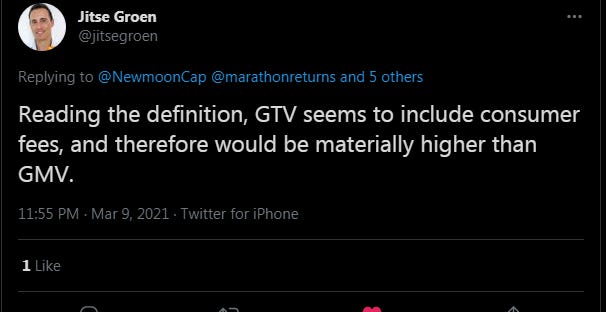Deliveroo part 5 - Top 10 red flags
Comment from Jitse ($TKWY CEO)
“I do know 2021 is going to look an awful lot different from 2020 in the UK.”

1. Casually firing 75% of its S&M employees
Yes...the sign of a healthy business that deserves to trade at over 20x LTM gross profit, firing 75% of your S&M staff in a single year.
2. Profitable in 2Q20 and 3Q20. What about 4Q20?
I mean… woohoo! Deliveroo is profitable (on adjusted EBITDA) in 2Q20 and 3Q20! But what about 4Q20? You are telling me the company can’t make a profit in 4Q20 despite all the tailwinds of COVID (higher AOV, more demand, maybe lower courier cost) and firing 75% of the S&M staffs. Pretty indicative of the unit economics of logistics food delivery.
Moreover, this doesn’t account for D&A and stock based compensation! I am pretty sure Deliveroo will be extremely unprofitable once we account for D&A and SBC.
Oh and by the way, $UBER is in a worse position than Deliveroo because it mixes to lower AOV orders.
3. No mention of $TKWY and $UBER
You would think Deliveroo would at least mention the names of their biggest competitors.
4. Deliveroo only has 250 Editions kitchen worldwide
This figure is absurd and laughable as it took 4 long years to open 250 kitchens, despite painting this as the future.
It makes absolutely no sense to be a vertically integrated cloud kitchen. As a cloud kitchen, it needs to maximize utilization to benefit from the high incremental margin (cloud kitchen is a high fixed cost business). If you were to start a cloud kitchen, why would you want to be exposed only to a fraction of the market’s demand, by being exclusive to Deliveroo? You would be pounding the table to be on all platforms in order to maximize sales.
The fact that Deliveroo only has 250 of these kitchens after 4 years is evidence that...maybe it’s not the best idea.
5. Introduction of Signatures doesn’t make sense
This introduction is either a major strategic mistake or a signal that Deliveroo is in trouble.
Signatures is Deliveroo’s white-label delivery business. It allows companies such as Nandos to leverage Deliveroo’s courier network to deliver food.
Rolling out Signatures is self-destructive as it dis-intermediates Deliveroo’s network. Doing so, Deliveroo is giving both the restaurants and consumers a reason to connect directly with each other, turning Deliveroo into a commodity (last mile logistics) in the value chain. This is deadly since Deliveroo’s orders are highly concentrated to a few large chain restaurants (e.g., Nandos, Wagamama, etc.). Note that 3 of Deliveroo’s top 5 restaurant partners are already using Signatures, and there is no reason why large chain restaurants wouldn’t want to connect directly to consumers. If 10 of Deliveroo’s top 50 chain restaurants were to churn to white label delivery, it would impair the health of the network significantly.
Now, we all know that food delivery is a network effect business, and Deliveroo agrees in the prospectus. In order for the network to work, Deliveroo must have unique inventories on its platform that are exclusive. Having unique and exclusive inventories is an understated competitive advantage. These inventories attract consumers which makes the platform more important over time, forming a virtuous cycle.
So why would Deliveroo offer a product that dis-intermediates itself?
I bet the reason is because Deliveroo recognizes that $TKWY is coming for them fire and fury, and burning its own network is the only way to keep the house warm.
6. What the heck is Gross Transaction Value?
We need this information to get a like-for-like view of market share in comparison to $TKWY. It is expected that Deliveroo articulate this information clearly. But for whatever reasons, Deliveroo decided to complicate things.
The second sentence contradicts the first. The first suggests it includes consumer fees as that is what consumers are paying. The second sentence suggests it excludes consumer fees. So which is it? Also, should there be a comma after the word discounts? Is discounts and consumer fees a group or are they distinct entities?
Personally, it seems like Deliveroo is being deliberately vague, which is probably not a good sign.
I am clearly not the only one being confused by this.
7. Food delivery 101 = order volume and AOV. Where are they?
I simply cannot reemphasize how ridiculous that Deliveroo has elected not to disclose AOV or order volume. This is again, expected of Deliveroo to articulate clearly. Those are food delivery 101 KPIs. Just what is Deliveroo attempting to hide?
8. Leading = #1 and #2. So “leading” means being number two now?
9. Riders fulfill orders in around 30 minutes, excluding wait time between orders
This implies 2 drops in an hour, at best. And much less if we account for the time couriers spend waiting for their next order.
So much for that courier network scale and technology.
10. Framing of the grocery opportunity is ridiculous
Am I the only one that finds this ridiculous and laughable? Deliveroo inferred that the on-demand grocery opportunity is big, because data suggest people don’t plan what to eat in advance.
The data simply mean people will eat out of their fridge, or order in food delivery.
I mean sure, there are bound to be users that use Deliveroo to deliver groceries on demand (those that decide to eat pork chops 30 minutes before they plan to cook). But that strikes me as a very small market. It is more probable that those customers will simple order food delivery.
Again, if on-demand grocery was really such a big market, why wasn’t it a thing before Covid? Read my previous post on this (Deliveroo part 2 - So what about groceries delivery?)
Bonus 11. Hammer from Italy1
“Italy demands €733M in fines from food delivery platforms”
“Couriers who worked for Uber Eats, Glovo, Just Eat and Deliveroo in Italy from 2017 to 2020 must now be treated as "coordinated and continuous workers," prosecutors declared
“I don’t know how they could manage to pay and remain alive,” said one European labor law expert.
How much of the fines belong to Deliveroo? We know that Deliveroo is half of the logistics gig economy in the past, so probably half (£300m) of the fine goes to Deliveroo — a large chunk of the IPO proceeds could be going towards paying fines.
Conclusion
It’s crazy that Deliveroo is trying to go public at over 20x LTM gross profit (more than $DASH) with 1/3 of the growth, none of the profits, decelerating order growth despite COVID (more on that in my next post), potential business model disruptions across Europe, and massive potential fines.
Links to other related parts:
Deliveroo part 4 - Hell is coming. Gross profit might decline by more than 50%
Deliveroo part 3 - How did Deliveroo managed growth in the past
Links to other related companies:
https://www.politico.eu/article/italy-demands-733-million-euros-in-fines-from-food-delivery-platforms/













Deliveroo has disclosed order volume? 70/115/178m in 2018/19/20